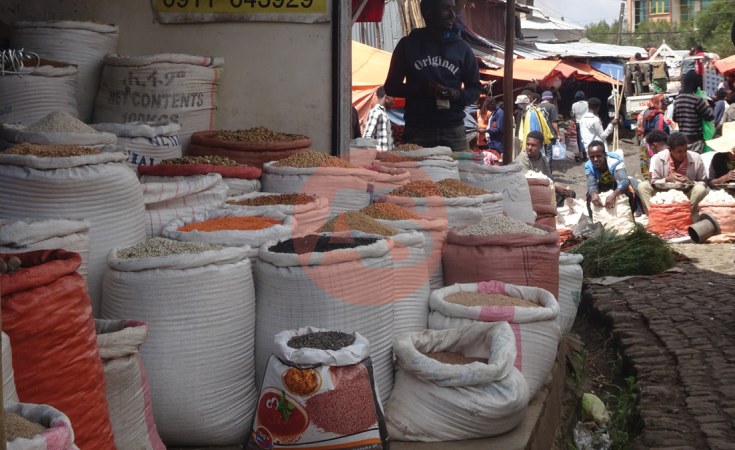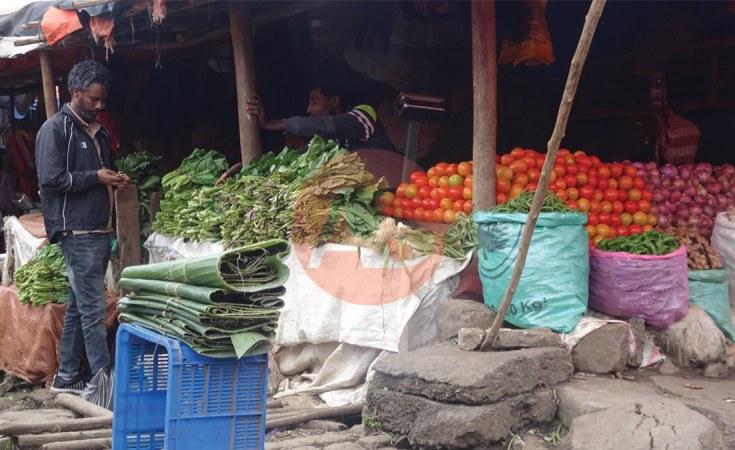Addis Abeba — In the bustling vegetable market of Kera, located in the heart of Addis Abeba, Addis Standard met Alemnesh Tibebu, a 48-year-old mother of three. Surrounded by a sea of bustling sellers and eager buyers, Alemnesh navigates through the crowd, determined to find the freshest produce for her family, particularly onions and tomatoes.
Alemnesh, a widow, has taken on the role of being the sole provider for her family ever since her beloved husband passed away nine years ago. Like many families living on fixed incomes, she has been deeply concerned as the prices of essential food items have skyrocketed in recent months.
In the past, Alemnesh, who works as a civil servant, used to purchase up to seven kilograms of onions at once, enough to sustain her family for an entire month. Just a few months ago, this would have cost her no more than 210 birr. However, the price of the same amount of onions has now surged to over 550 birr.
The cost of essential food items has hit record highs in recent months, with a kilogram of onions reaching a maximum price of 90 birr and tomatoes costing 80 birr per kilogram. These prices have remained high since the last Easter holiday, celebrated five months ago.
Experts argue that this alarming trend highlights an imbalance between food production and the growing demands of the population. In Ethiopia, smallholder farmers play a crucial role, accounting for 90% of all crop production. The latest survey by the Ethiopian Statistical Service revealed that nearly 14 million small-scale farmers, cultivating approximately less than half a million hectares of land, are primarily engaged in producing vegetables such as lettuce, cabbage, tomatoes, and root crops like onions, potatoes, and carrots. Last year, the country yielded 8.7 million quintals of vegetables and 41.4 million quintals of root crops.
The Oromia region stands as the largest producer of vegetables, accounting for 45% of the national vegetable production and 31% of root crop output. However, in a surprising shift, basic food items like onions are currently being sourced from unlikely places, including Mekelle and Sudan, to meet the rising demands. Wholesalers and retailers with extensive experience have also expressed their surprise at the recent upward price trend, which is unlike anything they have encountered throughout their long careers.
Abebe Tola, who has been in the vegetable wholesale business for more than two decades, sources his products from distributors in Addis Abeba but occasionally travels to his hometown of Zeway, located 168 kilometers from the capital, to directly purchase agricultural commodities from farmers. However, Abebe's business has faced significant instability lately. During his most recent trip to Zeway, he noticed a decline in the number of farmers willing to sell their products directly to wholesalers and other intermediaries. Similar changes were observed in Meki and Metehara, towns located in the east Shewa zone of the Oromia region, when Abebe visited recently.
"Farmers are shifting from cultivating crops such as onions, which have a shorter growth cycle, to long-term crops like wheat," explained Abebe.
This shift in farming practices has been prompted by the government's plan to reduce extensive wheat imports, which cost the country billions of birr each year, by cultivating wheat locally. Beyond self-sufficiency, the government aims to export wheat. According to the Food and Agriculture Organization's (FAO) Market Watch, the government plans to export 20% of the estimated 15.3 million metric tons of locally cultivated wheat this year.
Abebe argues that this decision fails to address the need for price stability within the domestic market, as the government's primary concern lies in stabilizing prices locally rather than looking to external markets.
Ethiopian consumers have long been familiar with price increases, but recent years have seen a significant rise in inflation rates, reaching over 20% in 2019. This has placed a heavy burden on individuals, particularly those with fixed incomes. The Ethiopian Statistics Service reported that inflation remained a pressing issue, reaching an alarming 33.7% last year. Food inflation was particularly concerning, standing at 40.2%. Although the monthly moving average food inflation rate decreased to 31% in July 2023, essential food items such as bread and cereals experienced a year-on-year inflation of 48.1%, while vegetables rose by 31.3%.
What makes the current food inflation rate different is the magnitude and level of price increases. For example, this year, the price of five liters of edible oil doubled within days, reaching an astonishing 1,000 birr, equivalent to a quarter of the monthly net income of Alemnesh.
The price of meat also tells a similar story. Despite being known as the top country in Africa with the highest cattle population, the cost of a kilogram of meat more than doubled last year, reaching a maximum of 1,500 birr. This forced Alemnesh to make the difficult decision to stop purchasing meat for her family, except on holidays.
Additionally, teff, a staple grain in Ethiopian cuisine, has experienced a drastic surge in price. Usually, teff prices stabilize during the months of February and March as the previous season's harvest enters the market. However, in March 2023, the price hit a record level, 67% higher than the previous year, with a quintal costing up to 11,000 birr in Addis Abeba, according to the FAO market watch.
As the cost of living has skyrocketed, individuals like Alemnesh find themselves trapped with stagnant incomes that haven't seen any growth in the past decade. Alemnesh earns a fixed monthly salary of 4,200 birr, but the value of her income diminishes at an alarming rate with each passing month, casting financial uncertainty over her livelihood.
A study titled "The Distributional Impact of Inflation," published in 2023 by Seid Nuru (PhD), associate professor of economics at the Ethiopian Economics Association, revealed that compared to middle and high-income groups, low-income families like Alemnesh's bear the most burden, as they are forced to spend over 65% of their earnings on food items. According to the study, the persistent increase in prices over the last twenty years has had a profound impact on households, causing significant welfare losses among consumers.

Alemnesh revealed that the harsh reality of skyrocketing prices for essential commodities like teff, bread, and cooking oil has compelled her to make significant changes by carefully reconsidering her spending habits and prioritizing her budget accordingly. She says eating out or buying new clothes for her children have become unthinkable luxuries. "I can't even imagine how families earning less than mine are surviving in this challenging environment."
The impact of food inflation in war-torn Tigray
The impact of food inflation in war-torn regions like Tigray cannot be overstated, with families facing severe challenges in providing enough sustenance for their children amidst skyrocketing prices. Girmay Assefa, a 35-year-old father of two and a high school teacher residing in Aksum, a town situated 107 kilometers away from the regional capital Mekelle, shared his concerns with Addis Standard about the health of his young children due to the family's meager diet compounded by soaring food prices. Speaking over the phone from Aksum, Girmay expressed his fear for the future physical growth of his kids.
"I fear for the physical growth of my kids," Girmay noted.
Girmay mentioned that although food prices remain high, there has been a considerable decrease since the conclusion of the fighting. For example, the cost of onions, which peaked at 130 birr per kilogram during the conflict, has now dropped by 30 birr. The signing of the peace agreement has also brought some relief in the form of reduced prices for essential commodities in Tigray. FAO's market watch reports a decrease of 22% in sorghum prices, 42% in maize prices, and 12% in teff prices.
However, Girmay highlighted the significant and unprecedented rise in the price of wheat. Two years ago, wheat cost a maximum of 3,500 birr per quintal, but the price has now surged to 18,000 birr. Girmay remarked that, despite the exorbitant price, obtaining a sustainable supply of wheat is almost impossible.
Similarly, the cost of essential items, such as edible oil, remains unaffordable in Tigray. In the region, five liters of edible oil can fetch up to 2,000 birr, which is more than double the price in Addis Abeba. Unfortunately, the purchasing power of civil servants like Girmay and other workers in Tigray has significantly declined compared to three years ago.
Despite earning a monthly net salary of 8,000 birr, Girmay, like many others, has not received payment for two years. Even after the signing of the Pretoria Peace Agreement in November 2022, regular payments to civil servants in Tigray have not been reinstated. Girmay, for instance, received his June salary in August 2023.
The inflated prices of food items in the Amhara region have been aggravated by the recent conflict between the federal government and the non-state Fano militia. The region's Trade and Market Development Bureau recently addressed the issue, stating that the price surge resulting from the conflict is negatively impacting the population.
Uncertain future
The escalation in food prices can be attributed to various factors, including conflicts, internal displacements, extreme weather events, and locust swarms, all of which have had a detrimental impact on agricultural productivity. Additionally, the ongoing war in Ukraine has exacerbated the price hike by raising the costs of commodities like petroleum, thus adding to transportation expenses along the supply chain.
However, experts like Tewodros Makonnen, a country economist at the International Growth Centre (IGC) Ethiopia, strongly believe that the loose monetary policy implemented by the National Bank of Ethiopia (NBE) is the primary catalyst for accelerating inflation. "Especially in the past three years, a massive amount of money has been injected into the economy to bridge the gap created by dwindling government revenue and escalating public expenditure," he stated.
Officials admit that this significant surge in circulating cash is partly responsible for the current high levels of inflation experienced in the country. During his recent address to the members of parliament, Prime Minister Abiy Ahmed emphasized that high inflation is the most critical issue facing Ethiopia. In response, he proposed a comprehensive macroeconomic reform plan with a primary focus on tightening monetary policy over the next three years.
Just a month after the Prime Minister's commitment to combat inflation, Mamo Mihretu, the Governor of the Central Bank, unveiled a detailed action plan with the goal of bringing inflation below 20% by 2024 and further attenuating it to below 10% by 2025.
To tighten monetary policy, the NBE will implement various measures, including limiting direct advances to the federal government so as not to exceed one-third of the amount provided in the previous fiscal year. Additionally, the NBE has decided to maintain the ceiling for domestic credit growth at 14%, which will require commercial banks to align their loan growth, which stood at 80% last year.
Policymakers hope that the combination of these proposed reforms and adjustments to the prevailing monetary policy will address the pressing issue of high inflation in Ethiopia. However, a macroeconomist who spoke to Addis Standard on the condition of anonymity had doubts over the practical implementation of such measures.
"Three years ago, the government vowed to limit the amount of cash injected into the economy and tame inflation," the macroeconomist recalled. "Yet, a massive amount of cash was flooding the market, which worsened the inflation even further."
In his study, Seid underscores the likelihood of prices increasing at a faster pace in the near future, attributing it to both domestic and global incidents that affect the supply of goods. To mitigate the negative consequences of inflation, particularly for low-income families, Seid suggests the implementation of policy interventions, such as targeted consumption subsidies, designed specifically to address the impact of rising prices on the impoverished segment of the population.


